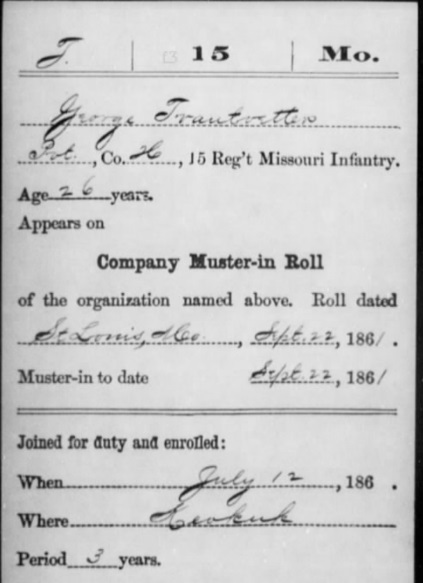In families where names are repeated repeatedly it can be easy to overlook one of the “repeatees.”
One of the best ways to avoid that is to research as completely as possible. For a long time I was unaware of one of the Georges in my family. That can happen when there are a seemingly endless number of them.
I knew that my ancestor, John George Trautvetter (1798-1871) and his wife Sophia Elisabeth Derle (1807-1877) had a son George Trautvetter. I knew this George was in the Civil War and had left descendants. I also knew that John George had bothers Henry, Adam, and Michael. Adam and Michael died without children. When Michael died intestate in 1869, Henry’s children Christian, Ernestine, and Michael were listed as Henry’s heirs since Henry had already died.
Seemed pretty cut and dried. However, one has to remember that probates are generally only interested in living heirs or deceased heirs who left descendants. Deceased heirs who left no descendants of their own are usually not mentioned in such probates.
Such is the case with George Trautvetter. He appears as the apparently 27-year old George Trautvetter enumerated with his parents, Henry and Barbara Trautvetter in Hancock County, Illinois’ Montebello Township in 1860. There are other family members in the household, including George’s brother Adam, his sister-in-law Eve, and some of George and Eve’s children. One might be tempted to think that perhaps George died in the Civil War given that the last known reference to him is in 1860. That would be reasonable speculation, but it turns out to only be partially true.

It turns out the last reference to George is likely not the 1860 census.
It is still not known when George died, but he is believed to be the George Trautvetter who served in Company H, 15th Missouri Infantry. The last card in George Trautvetter’s compiled military service record (original at the US National Archives and available online in several locations) for service in Company H indicated that he enlisted in “Keokuk” on 12 July [1861] and was mustered in on 22 September 1861 in St. Louis. That reference to “Keokuk” is likely to Keokuk, Iowa–right across the Mississippi River from where the Trautvetter family was enumeration in 1860 and also along the Missouri/Iowa border.

It may even be worth my time to look up local newspaper articles at the time of George’s enlistment in July of 1861 to see if there’s any reference to enlistments or recruitment. It’s doubtful his name will be specifically mentioned, but there may be some sort of reference to “Hancock County boys” or something suggestive that locals were crossing the river to enlist. Newspapers should be utilized until the muster-in date as there may be mention of the recruits heading down to St. Louis.

No responses yet